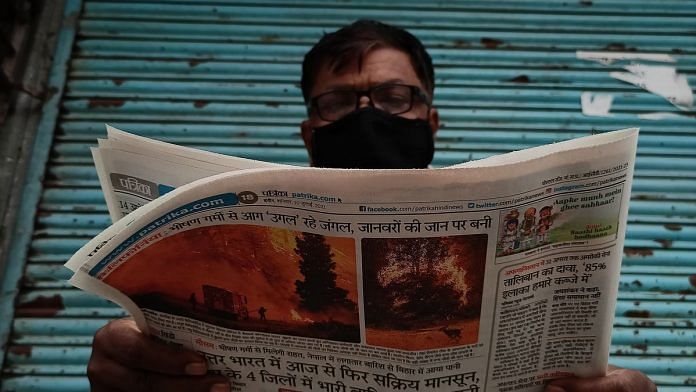New Delhi: Indians seem to be losing their appetite for news and entertainment when delivered through traditional mass media like newspapers, magazines, radio, and TV.
Data released this month from the National Family Health Survey (NFHS)-5, conducted between 2019 and 2021, shows that there has been a double-digit percentage decline since the 2015-16 NFHS-4 in the share of people who read newspapers or magazines, watch TV, and listen to the radio at least once a week, which is the study’s benchmark for regular consumption of mass media. For cinema, a once-a-month visit is considered regular.
In the 2015-16 period, 25 per cent of women and 14 per cent of men claimed they were not regularly exposed to mass media (including cinema), but the percentage shot up to 41 per cent and 32 per cent, respectively, in 2019-21.
Some industry experts warn, however, that the NFHS data is not comprehensive in scope and makes no mention of the types of digital content that people consume.
Mohit Jain, president of the Indian Newspaper Society, believes that the NFHS-5 data is not in line with what the industry has observed — news readership has increased, owing to its availability on digital platforms.
“The news media, specifically the newspaper industry, has transformed a lot and merely looking at the statistics of physical newspapers could give us misleading trends,” Jain told ThePrint.
However, Vibodh Parthasarathi, an associate professor who teaches media policy at Jamia Millia Islamia in Delhi, pointed out that while the NFHS-5 data did seem to be contrary to “industry claims”, it was also concerning.
“The sharp decline in exposure to print and TV news media could be interpreted to indicate unaffordability or/and a self-sanctioned media withdrawal on part of the citizen,” he said.
Also Read: Why most Indians don’t trust news? A study of land conflicts answers
A rise, followed by sharp drop
There had been an increase in TV, magazine, and newspaper exposure for men as well as women between 2005-06 and 2015-16, according to NFHS data. However, the trend reversed by the time of the 2019-2021 period of the survey.
Data shows that, in the last five years, the share of people who were not regularly exposed to mass media has almost doubled. In the latest round of the survey, about 32 per cent of men and 41 per cent of women said they were not regularly exposed to mass media, compared to 14 per cent men and 25 per cent women in NFHS-4.
For NFHS-4, 699,686 women between the ages of 15-49 and 112,122 men between the ages of 15-54 were interviewed, while the number of respondents for the NFHS-5 was 724,115 women and 101,839 men across the same age groups.
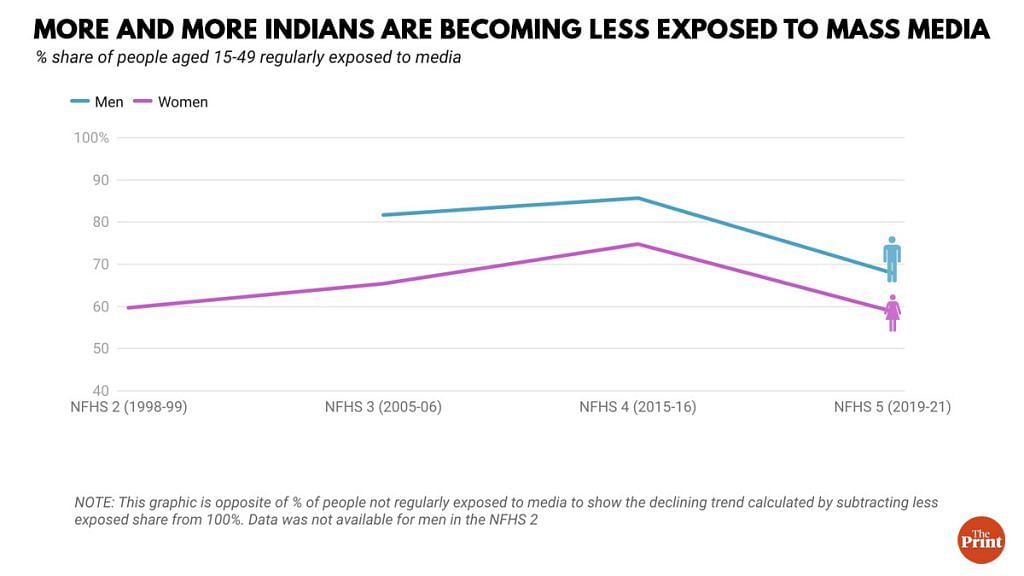
The trend between NFHS-3, conducted in 2005-06, and NFHS-4 told a completely different story.
In NFHS-3, about 18.3 per cent men and 34.6 per cent women had reported that they were not regularly exposed to mass media. From then until NFHS-4, therefore, the consumption of mass media had increased.
Men putting down newspapers, women turning off TVs
Data shows that men have reported the steepest fall in reading newspapers or magazines, while women have distanced themselves from TV the most.
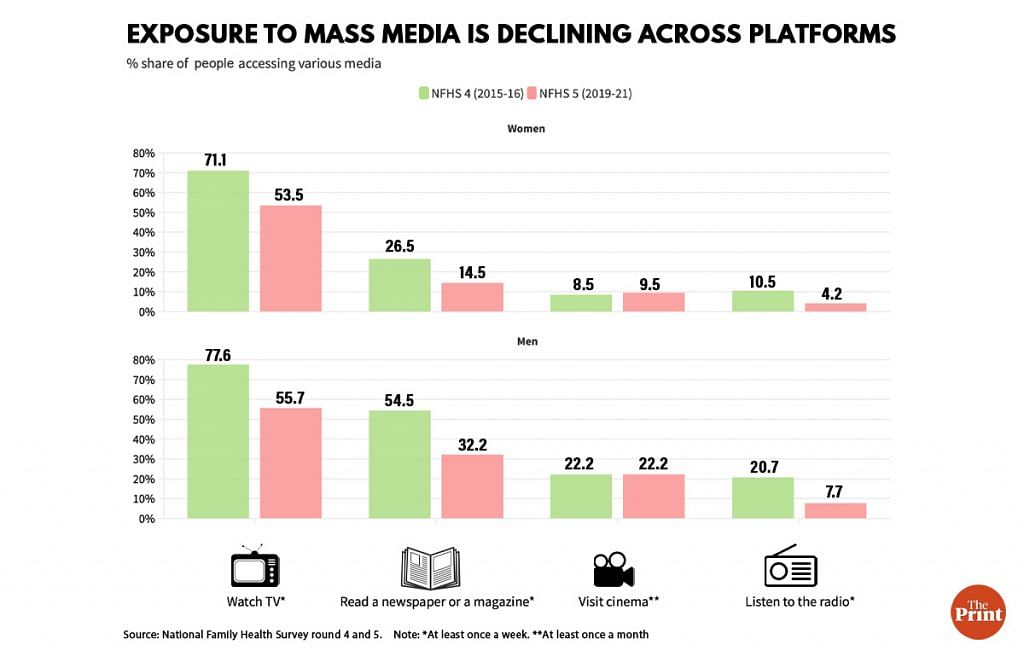
In 2015-16, about 54.5 per cent of men were reading a newspaper or a magazine at least once a week, which has fallen down to just 32 per cent in 2019-21. The share of young men (15-49) watching TV at least once a week has also fallen significantly, from 77.6 per cent in 2015-16 to 55.7 per cent in 2019-21.
In 2015-16, there were at least 71.1 per cent women — more than two in every three — watching TV at least once a week. By 2019-21, only 53 per cent were tuning in this often.
In 2015-16, just over a quarter of women respondents read a newspaper at least once a week, but that too has come down to only 14.4 per cent in the latest round of the survey.
Between NFHS-4 and NFHS-5, the share of men listening to the radio has come down from 20.7 per cent to 10.5 per cent, and from 7.7 per cent to 4.2 per cent for women.
Income plays a role
Based on past rounds of the NFHS, the income level of a person and their exposure to mass media are positively correlated. In general, wealthier people tend to read newspapers, watch TV, and listen to the radio more often than those who are less privileged.
That trend has remained intact. But, there is a caveat: Even as their overall share of media consumption remains higher, these groups have witnessed some of the sharpest falls in their exposure to TV, print, and radio.
There has been an especially dramatic drop in the newspaper and magazine readership of women in the highest income group.
While in the 2015-16 survey, more than 60 per cent women in the highest wealth group said they were reading a newspaper or a magazine at least once in a week, in 2019-21, only 34 per cent claimed they were doing so.
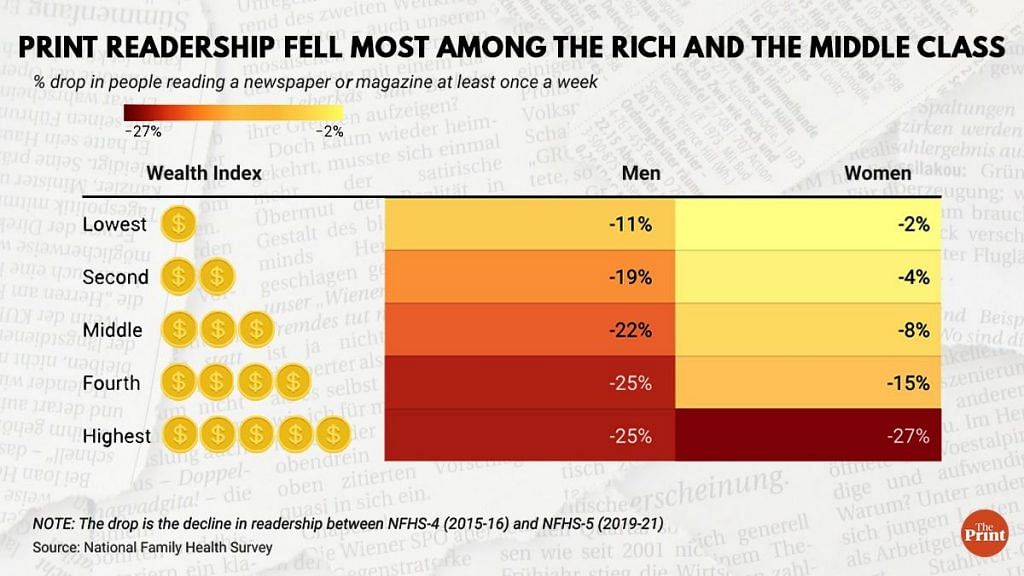
The decline in newspaper readership was steep for prosperous men too. For men belonging to the top three income groups, the drop in print readership was more than 20 percentage points between the two consecutive rounds of the survey.
Regional variations
NFHS-5 data shows that people living in some eastern and northeastern states, many of which lag behind the average income in India, are the least exposed to mass media.
More than 65 per cent women and 53 per cent men in Jharkhand reported that they were not regularly exposed to mass media. Neighbouring Bihar recorded similar responses — 67 per cent of women and 48 per cent of men did not consume mass media regularly. On average, more than half the people in Meghalaya, Nagaland, and Assam are also reportedly not regularly exposed to any mass media, a trend that was also found in Uttar Pradesh.
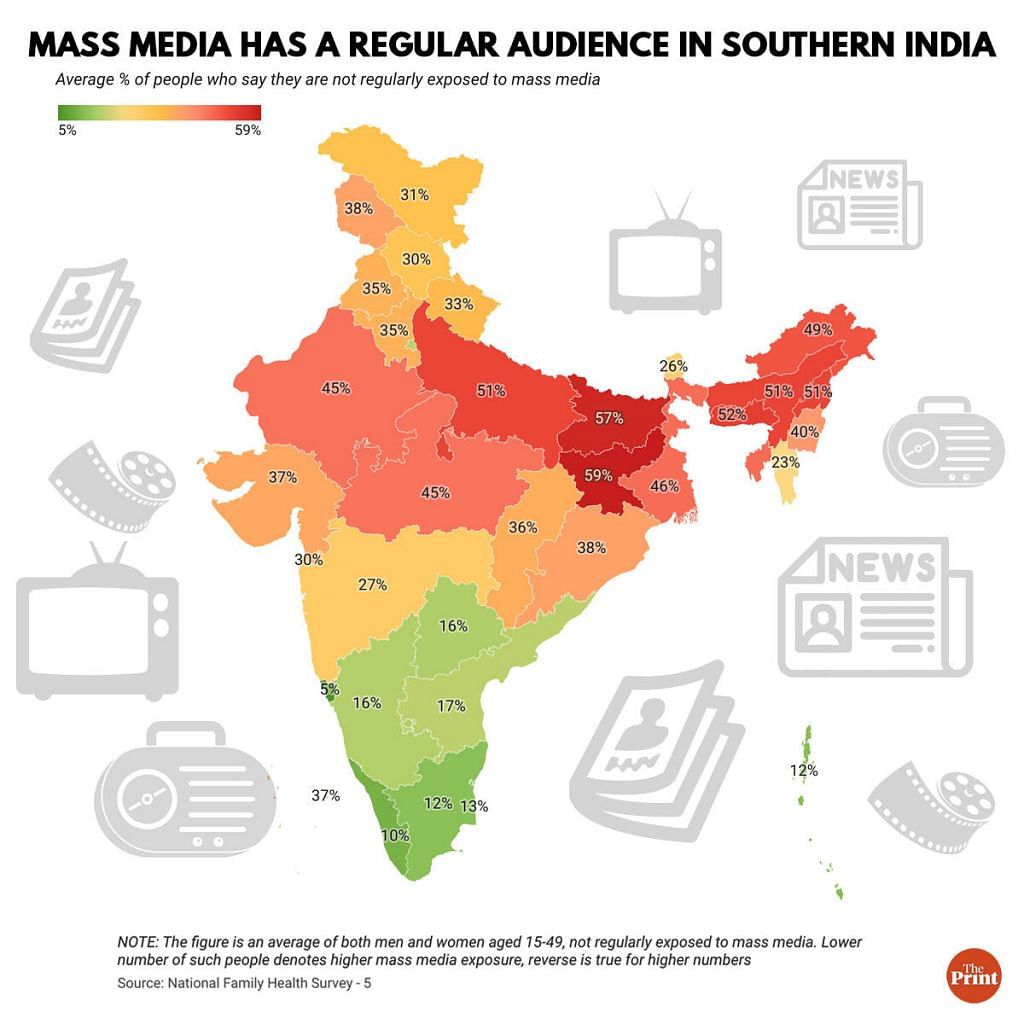
The picture is completely different in the wealthier states in southern and western India. Only about 8 per cent of women and 2.3 per cent men in Goa said they were not regularly exposed to mass media, followed by Kerala (13.3 per cent women, 7.1 per cent men).
In Tamil Nadu, Telangana, Karnataka and Andhra Pradesh, the share of people not regularly exposed to mass media was less than 20 per cent. National capital Delhi, too, has only about 17 per cent people reporting they are not exposed to any media regularly.
An important missing piece
What the NFHS-5 data fails to address is changing patterns in how Indians are consuming their news and entertainment.
“I think we need to look at the composite statistics. Newspapers and their content are available in both physical and soft format (internet). What we have observed is that, during the lockdown era, the reading habits of Indians have just improved,” Mohit Jain, president of the Indian Newspaper Society, said.
“People are spending more time on reading newspapers and content online. The lockdown brought them more leisure time, some of which was channelised in reading,” he added.
Numerous studies have highlighted that digital media, including news, is on a steep upward trajectory in India.
For instance, a December 2021 report — titled ‘The Future of the News in India’ — noted that “a digital-first landscape is emerging for news” in India. Commissioned by Google and prepared by the research arm of the global development consulting firm Dalberg, this study said that digital was the fastest growing medium in the Indian market, with a compound annual growth rate (CAGR) of 25 per cent between 2012 and 2019.
This study also forecast that online news would reach more than 70 crore Indians by 2026, but that print consumption would fall by 20 per cent.
Similarly, the last round of the Indian Readership Survey, conducted by the Media Research Users Council of India (MRUC) in association with research firm Nielsen India, showed that, between 2017 and 2019, traditional media consumption was relatively stable but digital media witnessed phenomenal growth.
This report showed a 2 per cent decline in newspapers, a modest 7 per cent increase in TV, but a 123 per cent rise in digital media consumption.
(Edited by Asavari Singh)
Also Read: Fact vs fiction: National Family Health Survey busts some myths about Muslims in India



